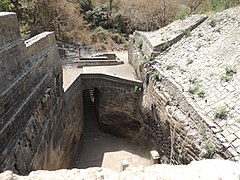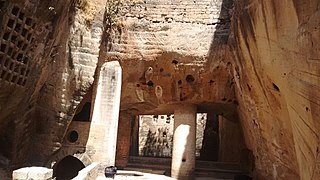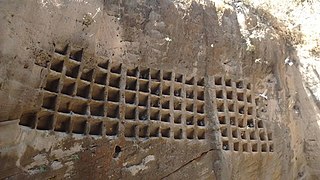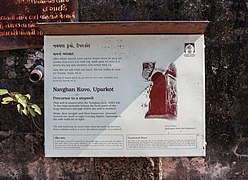Navghan Kuvo
| Navghan Kuvo | |
|---|---|
 Flight of steps leading to forecourt of the stepwell | |
| General information | |
| Type | Stepwell |
| Architectural style | Indian architecture |
| Location | Uparkot Fort |
| Town or city | Junagadh |
| Country | India |
| Coordinates | 21°31′26″N 70°28′09″E / 21.5238°N 70.4692°E |
| Construction started | 2nd-7th century |
| Completed | 11th-12th century |
| Design and construction | |
| Architect(s) | Local |
| Designations | ASI State Protected Monument No. S-GJ-116 |
Navghan Kuvo is a stepwell in Uparkot Fort, Junagadh, Gujarat, India.[1]
History
Navghan Kuvo is named after the Chudasama king Ra Navaghana. The forecourt to reach the well was probably built during his reign in 11th century. It is believed to have been completed by his son Khengara.[1]
The well is considered older than the forecourt. It is an oldest example of the stepwell according to some scholars. It is near the Uparkot Caves. The well might have been built in Kshatrapa period (2nd-4th century) or in Maitraka period (6th-7th century).[1]
It is a state protected monument (S-GJ-116).
Architecture
A small staircase entered through an arched doorway leads to the forecourt. The well is located at the far end of the forecourt. The water in the well is reached by a circular staircase which is cut in the soft rock behind thin stone wall of the shaft of well. The flight of the steps, first straight and then transverse, turns right around the shaft. The array of square holes in the stone wall of the shaft illuminate and cool the inside.[1][2][3]
Gallery
-
Entrance of the stepwell
-
Forecourt
-
Forecourt
-
Forecourt from steps
-
Soft rock hewn to make niches for birds
-
Information board
See also
References
- ^ a b c d Jutta Jain-Neubauer (1981). The Stepwells of Gujarat: In Art-historical Perspective. Abhinav Publications. pp. 22, 27. ISBN 978-0-391-02284-3.
- ^ Anjali H. Desai (2007). India Guide Gujarat. India Guide Publications. p. 254. ISBN 978-0-9789517-0-2.
- ^ Morna Livingston; Milo Beach (April 2002). Steps to Water: The Ancient Stepwells of India. Princeton Architectural Press. p. 21. ISBN 978-1-56898-324-0.







